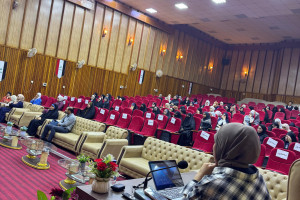
|
12:20 (7 minutes ago) |
|
||
|
||||
Faculty member publishes a new book entitled “Significance of Contrastive Grammar in the Translation across Arabic and English”
Media Unit/ College of Education/ Al-Qurnah
Dr. Jawad Kadhim Jaber, faculty member of the Univeristy of Basrah who is a lecturer at the College of Education / Al-Qurnah- Department of English has issued a new book entitled “Significance of Contrastive Grammar in the Translation across Arabic and English”.
The book consists of eleven chapters: The first chapter deals with the history of contrastive linguistics and the theories that contributed to its spread and the benefit of contrastive linguistics in teaching language and translation. The second chapter deals with the patterns of sentence structure in the Arabic and English languages, the differences between them and the difficulties facing the translators in this field. The third chapter deals with the forms of the Arabic verb and its comparison with their counterparts in the English language. The fourth chapter deals with the names in Arabic language and its types and basic rules and the role of syntactic movements in influencing the meaning and how to transfer this matter to the English language. In the fifth chapter, it exhibits the types of pronouns in the Arabic language and their equivalents in the English language.
In the sixth chapter, the prepositions and the meanings that they give and their effect on the translation process into the English language are dealt with. The seventh chapter deals with the subordinates in the Arabic language which included the style Emphasis, prompts, adjectives, and sympathy, and their comparison with the appropriate methods in the English language. In the eighth chapter, the method of negation in the Arabic language was addressed and the essence and methods of negative in it and how to transfer these methods to the English language in a professional and accurate manner.
As for the ninth chapter, the definitive and non-assertive conditional tools and how to properly transfer them into the English language are dealt with because these sentences are among the types of sentences that the student faces difficulties in translating them. The tenth chapter explains the issue of grammatical congruence was addressed in both the Arabic and English languages. In the last chapter, there is a review of the book’s topics in a very useful deductive manner for those interested in contrastive linguistics. The book aims to highlight the importance of contrastive grammar in the translation process from Arabic into English








